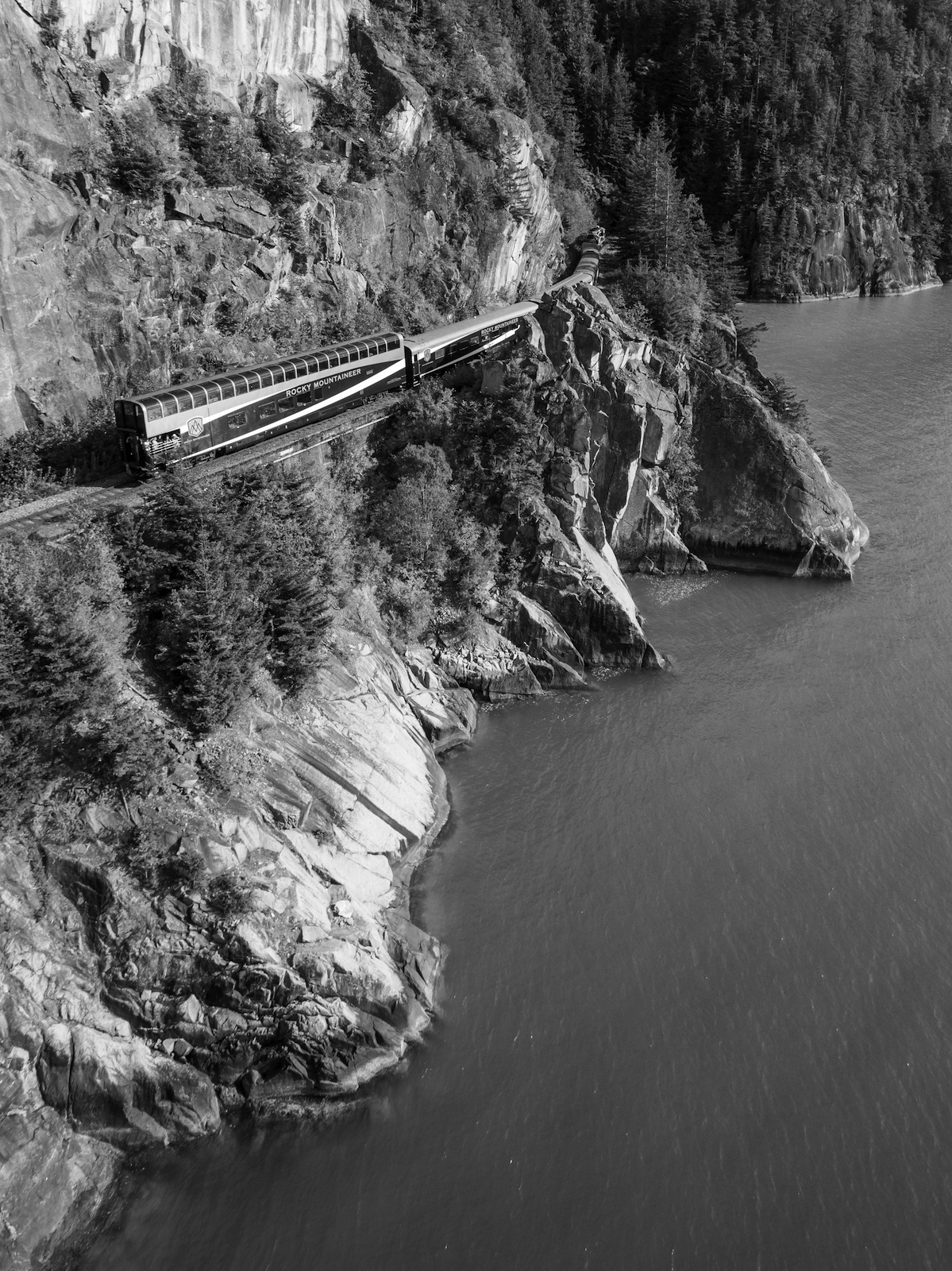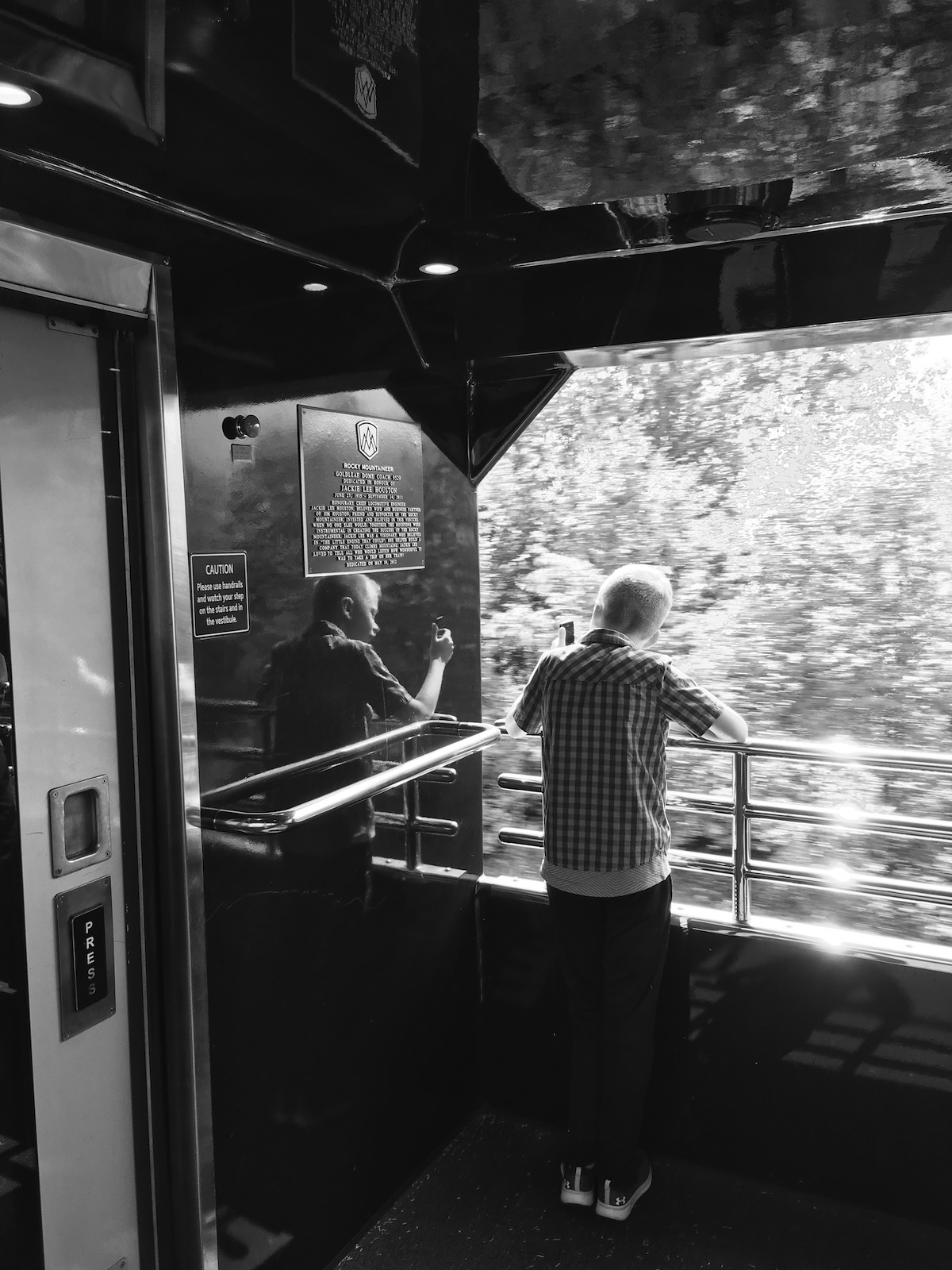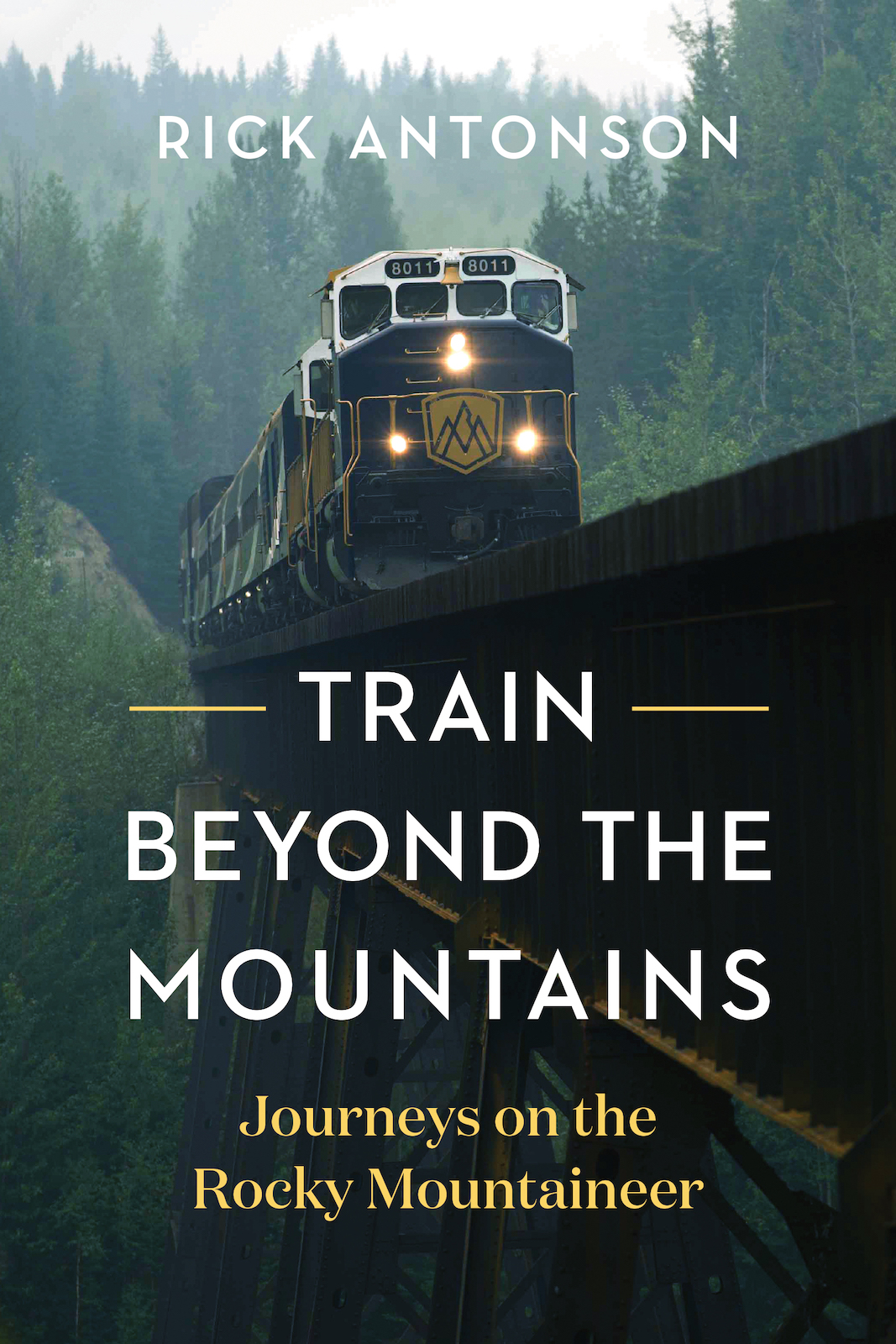Rick Antonson thought he knew everything about train travel—until he embarked on a journey with his young grandson. The former vice-president of Rocky Mountaineer shares stories from that memorable trip, along with interesting tidbits from the company’s history, in Train Beyond the Mountains: Journeys on the Rocky Mountaineer.
An early decision for any traveller is whether to go alone or go with someone else.
My plan for this particular journey was to board the westbound Rocky Mountaineer in Banff, Alberta, to take the train beyond the mountains. Later, I’d depart from Vancouver, British Columbia, aboard another train bound north by northeast, venturing back for a spell in the Rocky Mountains. My first impulse was to go solo, as that makes it easier to get into those awkward situations where stories live. Yet to be on one of the world’s great trains was too special not to share. My motivation was to enjoy the simplicity of train travel: meandering through time to the soothing rhythm of the tracks, with few responsibilities. Such a temptation begs for an accomplice. Spontaneously, I invited my ten-year-old grandson. Riley was eager from the start: “You’ll be so happy to have me along, Grampa.”

Photo of train on Stoney Creek Bridge courtesy of Rocky Mountaineer.
Train travel is an ongoing moment. It is the continual unfolding of anticipation and understanding. I got more of those than I envisaged when Riley and I were aboard Rocky Mountaineer’s bi-level coach. Often he’d say, “Let’s head to the back of the train, Grampa.” There, on the lower level’s open-air observation deck, Riley would lean into the summer wind, tousle-haired, eyes alight, as the train rolled down the tracks of time. His grin reflected the pure joy of a child’s ability to live in the now. He’d squint at the trees (“What’s that one, Grampa?”), frown at dilapidated farmhouses (“That’s sad.”), or offer insights (“You’re not as easy to travel with as I’d hoped.”).
I wanted to share the gifts of train travel with my grandson: the gift of unexpected relaxation (it’s like a long walk without the footwork); the gift of discovering new friends (each with a story to tell, or a secret to hide); the gift of time to think (or, for a kid, to play video games on a tablet). And I wanted to see everything anew through Riley’s eyes, one-seventh the age of mine.
One recent summer morning at the Banff train station, I stood beside twenty-two freshly washed coaches headed by a powerful diesel engine idling on a track. Each coach was adorned with a wave of white, topped with a blue swoosh below its rooftop’s gold ribbon, broken only by its bent-glass ceilings. I could imagine the entire train seeming to undulate as it moved along the tracks. The engine had an emblem with mountain-sharp R and M lettering merged into a graphic with “Rocky Mountaineer” printed below.
Three decades ago, I was vice-president of the Great Canadian Railtour Company (GCRC) for the first three years it operated the Rocky Mountaineer. I was responsible for sales and marketing, reservations, and loose ends, of which there were many. The entire time I worked with the company we were on the brink of bankruptcy. I once knew this train and from whence it came; I wanted to see what it had become since that era, this time as a passenger. It struck me how much had changed since then, even at a superficial level: the coaches had matured from rust and tarnish to gold-and-blue beauties. Well over half the coaches were two-level dome cars with seats on the upper level under a glass roof, and a dining room on the lower level, where I could see the places set for breakfast. The rest were mid-century coaches updated in style, and with enlarged windows that arched at the roof, and seating that would let one “take it all in.” There were no sleeping cars: everyone onboard would stay in hotels overnight at the midway town of Kamloops. This ensured the entirety of our two-day trip would be in daylight, thus avoiding the major complaint about earlier train services passing through some of the most stunning scenery at night. There were no baggage cars, as everyone’s main luggage had already left in a truck to be reunited with travellers when they arrived in their hotel rooms that night.
The Rocky Mountaineer has no equivalent in North America. Its few comparable one-of-a-kind train experiences along heritage tracks are found on other continents. Elegant train travel has, by way of revival, come into its own in recent decades, often with the retrofitting of a once grand train, or a renewed interest in legendary routes, or, more rarely, the launch of elaborate and unexpected new trains.

Photo courtesy of Rocky Mountaineer.
“We should have done this years ago,” an elderly man said, watching a family with two teenage kids pose for selfies. “We could have brought our kids before they got so busy.”
“We’re here now.” His wife smiled. “Best we get on board. It’ll be two days before the next departure.”
I was shielding a cup of hot chocolate against a cool mountain breeze. At moments like that I often contemplate the old saw: “Each day lies before us as a blank page. What will we do to write its story?” The answer, of course, is to take the first step.
“Let’s go, Grampa,” chided my now constant companion, Riley, “or me and this train will leave without you.”
There was a confidence in Riley as he stepped aboard the Rocky Mountaineer. What put that spring in my grandson’s stride? Was it the sense of freedom so prevalent among train travellers?
Riley’s grin echoed my own childhood excitement about a train jaunt I had made more than sixty years ago with my grandmother through the Rocky Mountains. Today that journey evokes a wistfulness I hope to never lose. The refrain from an outbound train, or being wakened in the middle of the night by a distant train horn, stirs in me the want of being elsewhere.
Riley is tall for a kid his age, which has thinned him for the time being. He has his mother’s looks, which, speaking as his father’s father, are the better set of genes for that. A spike of his blond hair flares blue. He’s an able camper; we’ve slept out under the stars. Soccer is one of his sports, video gaming another. Impatient for life (and with people), he’s up for adventure, and he has no known fears. (A year before, he’d plummeted 171 feet (52 metres) off a bridge on a bungee cord.) It interests him to be unpredictable.
“Travel sits on the right hand of peace.”
Growing up, I was encouraged to run toward life, to not measure what one had done but rather to assess what might be on the horizon. My father said to my siblings and me that you often have to make a choice: “You can do, or you can have.” I’d made up my mind to do whatever experiences I could, forsaking the possessions. It had worked out favourably, so far—and I wanted to pass that lesson along to Riley, particularly the meaningfulness of travel experiences. While there is much left for me to learn, I’m aware that travel is the world’s synapse. By connecting people from around the world, it takes down barriers to understanding. Travel lets us celebrate our differences. I once heard a cabinet minister in India say, “Travel sits on the right hand of peace.” If it can do that for countries, what might it do for a grandfather and a ten-year-old?

Photo courtesy of Rocky Mountaineer.
There was a hum among passengers as the diesel horn sounded its boarding announcement, nudging those still standing in awe of the station’s surrounding mountains. Little did they know they were staring at appetizer scenery. More awe lay around the bend: the unremitting beauty of the landscape enhanced by the meeting of fellow travellers, and the enjoyment of gourmet meals and a level of service seldom encountered in today’s world of trains. This was not a checklist trip. This would be a defining trip, their journeys filled with meaning and purpose.
A discussion on the platform interrupted my musings. Two couples of a certain age were jousting over their upcoming week. There was camaraderie in the air around them, friendly but combative. Someone was about to lose an argument.
“I told you so,” said one of the men. “It’s going to be great.”
“It’s going to be slow,” said a woman. “Two days to Vancouver. We could fly there in an hour.”
“And what would you see?” the man asked.
“The back of someone’s head,” she answered. “But only for sixty minutes.”
“Oh, I love trains,” said the other woman, laughing at the exchange. “I was on a train in the ’90s with my first husband. Nothing like this one, though.” I was unsure if she was comparing husbands or trains. Eyes front, I told myself. The second man joined the verbal pile-on. “I’ve travelled on elegant trains all over the world. Last year we were on Peru’s Andean Explorer to Cusco, before that we went to Lhasa from Beijing on the Qinghai to Tibet Railway, and now . . .”
“And now this . . .,” the first man interrupted, spreading his hands and giving a half bow of respect toward the train. Their banter transported me back decades in my own little world of trains to a time when I was a sponge for new stories, particularly those from old codgers who had travelled widely, especially if they had done so by train. The two couples echoed what I sensed: even though I’m now an old codger myself, one can glean much about life rolling along on a train, day after day, distracted by fresh vistas of the mind as well as of the eyes.
“Let’s go,” Riley said again, disappearing onto the train. I placed my foot where Riley’s had been and followed him aboard.
We found our seats and settled in. The train horn blew its farewell. Our engine pulled. Our train tugged. We were leaving the station and heading into the blank pages of the stories that lay ahead. Bystanders and Banff station staff waved us off. Fellow travellers greeted us. Riley nodded goodbyes and said hellos, as would a seasoned traveller. I had no doubt he’d want me to explain the landscape and talk him through the local history, and share the lore of international rail travel. He’ll be hanging on my every word of wisdom, I thought. He must know how lucky he is to have me along to amuse him.
“Grampa, please pass me my tablet.”

Photo of Riley by Rick Antonson.
Adapted with permission of the publisher from the book Train Beyond the Mountains: Journeys on the Rocky Mountaineer, written by Rick Antonson and published by Greystone Books in April 2023. Available wherever books are sold.
Read more transportation stories.









